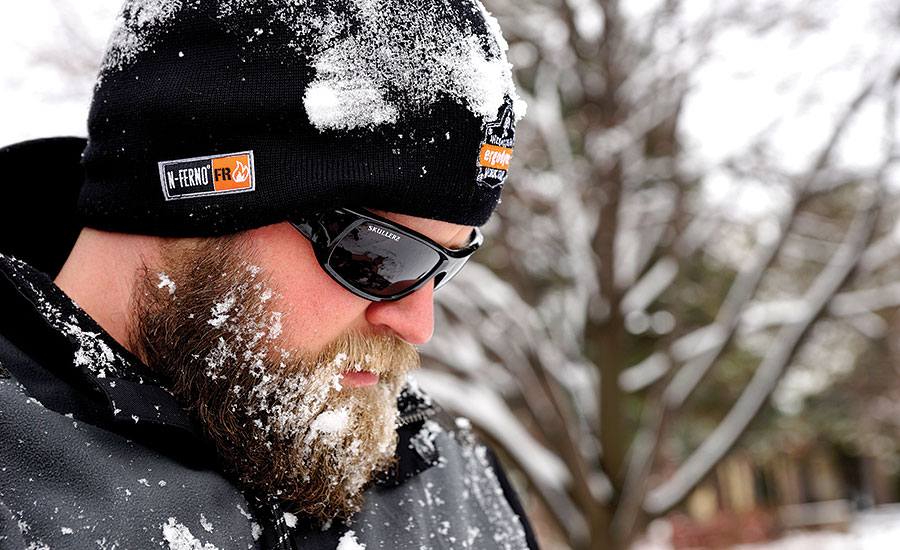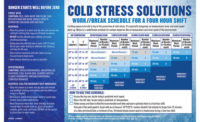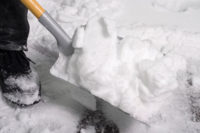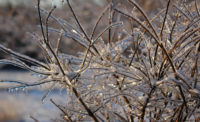In 2014, prolonged exposure to cold killed 43 people in the U.S., nearly double the 2013 number. But we refuse to accept this as a mere fact of life. Coupled with the right controls and proper personal protective equipment (PPE), we can reduce this number to where it should be: zero. Prepare yourself to stay compliant and protect your workers when winter’s chill inevitably sets in.
What do regulators say?
There are no specific cold weather standards for workplaces covered by OSHA. 1910.132 allows an exception to the requirement to provide PPE for workers, stating that employers do not need to provide workers with “ordinary clothing” or gear and clothing that is “used solely for protection from weather, such as winter coats, jackets, gloves, parkas.”
Still, many employers in cold climates choose to provide workers with some level of winter weather gear, like coats and gloves. Due to hard hat manufacturer requirements, employers often supply a compliant hard hat liner to help insulate personnel from the cold.
The Canadian Centre for Occupational Health and Safety (CCOHS) has fact sheets available on cold stress prevention. It recommends wearing protective clothing for work at or below 39F (4C). Clothing should be selected based on the type and duration of the work activities, weather conditions like wind and rain, and the air temperature.
Work the hierarchy first
Apply the hierarchy of controls to cold stress risks. First, outdoor work should be scheduled, if possible, on warmer days or seasons.
If workers can be rotated in and out of the cold conditions, this is the next best control. Regardless, you should provide your workers with a warm break location and limit their time in the cold. Remind your workers to carry extra socks, gloves, hats, jacket, blankets, an extra jacket, and a change of clothes. Keep chemical hot packs in your first aid kit.
The last piece of the hierarchy is personal protective equipment. This article will help you chose the right garments based on fabric and technology, so you can dress properly for cold working environments.
Layer up
OSHA provides some guidance on how to dress properly for frigid temps to prevent cold stress. When you can’t avoid cold environments or temperatures—indoors or out—the regulatory agency suggests wearing at least three layers of loose-fitting clothing. Layering is known to provide better insulation from the cold.
Let’s break them down:
1. Inner Layer: Should keep moisture away from the body. Consider thermal wear or garments made of wool, silk, or a synthetic like polypropylene that hold more body heat than cotton.
2. Middle Layer: Should provide insulation, even when wet. Consider wool or synthetic garments.
3. Outer Layer: Should allow ventilation to prevent overheating while also protecting from wind and rain to keep the wearer dry.
To protect your extremities, choose boots and gloves that are insulated and waterproof. Reach for headwear that will cover your ears and your head. You may also want to wear a knit mask to cover your face and mouth. Why? About 50 percent of body heat is lost through the head.
CCOHS suggests wearing inner layers that “wick” moisture away from the skin to help keep it dry. It also advises that additional layers of clothing should be “easy to open or remove” during strenuous activity. This is to prevent the worker from overheating or sweating excessively. The outer jacket should have a “means for closing off and opening the waist, neck, and wrists to help control how much heat is retained or given off.” Finally, it recommends heated protective clothing for work done in bitterly-cold environments.
No matter which fabrics you choose for your layers, select clothing that is loose-fitting. Tight clothing can reduce necessary blood circulation to the extremities. As with all protective clothing, it’s important to maintain your PPE’s condition. Dirty air cells in the fibers of clothing can reduce the garment’s insulating capabilities. Always follow the manufacturer’s instructions for care and cleaning of protective clothing.
Even working in cold temps can lead to perspiration. To prevent excessive sweating, remove your clothing in this order: mittens or gloves, headgear or scarf, then open the jacket at the waist and wrists and, finally, remove layers of clothing. As you cool down, follow the order in reverse. Keep your mittens or gloves on if you need protection from snow and ice.
Creature comforts
As you’ve read, there are many factors that go into choosing the RIGHT warming gear. From head to toe, refer to the below for a quick overview of the best choices:
• Pick a power heater: As previously mentioned, CCOHS recommends heated protective clothing when working in extremely cold environments. A water- and wind-resistant heated jacket with heating technology is a great match for tough environments.
• Hand protection: Gloves may be the hand protection of choice for many workplaces, but when the temperature dips below 1F (-17C), CCOHS recommends using mittens for warmth. Depending on the dexterity required for the work activities, administrative controls like work rotation or work stoppage may be required.
• Pick wool, not cotton: Cotton is not a good fabric to wear in cold environments because it gets damp or wet too quickly and loses any of its insulating properties. Wool and synthetic fabrics, on the other hand, are recommended because they retain heat when wet.
• Protect those toes: Don’t forget your feet! Felt-lined, rubber-bottomed, and leather-topped boots with removable felt insoles are best for heavy work in the cold. The leather is porous and allows the boots to breathe by letting perspiration evaporate. Workers should waterproof their boots with products that don’t block the pores of the leather.
• Make sure it fits: Choose your socks based on your boots. If they are too thick, the boots will feel tight and the socks will lose their insulating capabilities when they are compressed inside. If they are too thin, the boots will fit too loosely and may cause blisters. In extremely cold weather, you may prefer to wear two pairs of socks. One inner sock made of silk, nylon or thin wool, and a thicker, larger outer sock.
Bottom line
When temperatures plummet and the work has to get done, braving the cold shouldn’t be about brute strength. Armor up in the right PPE, take breaks from the cold, and plan ahead.
Resources
• OHSA
• 29 CFR 1910.132 Personal Protective Equipment
• CDC/NIOSH Fast Facts – Protecting Yourself from Cold Stress
• Canadian Centre for Occupational Health and Safety – Cold Environments Fact Sheet
• OutDry Company Profile and Product Information



